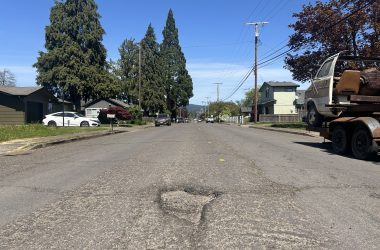
GLENWOOD – What’ll it be? A soccer arena and an ice rink, or a 20-story hotel on Glenwood’s riverside?
The Springfield Economic Development Agency (SEDA) heard unsolicited pitches from two developers: Glenwood Development project pitched a 20-story hotel, and LOCALIS Partners proposed a soccer stadium and a skating rink. Both proposals include plans for various grades of housing, conference/hotel structures, parking, eateries and retail shops.
Mike Eyster, a community leader who ran for Mayor in 2019, said that both proposals are “strong,” and far more lucrative than the scrapped indoor track facility at that location in 2020.
“Unlike the earlier proposed indoor track, these proposals would generate millions in tax revenues … Both would draw thousands of visitors to the area each year. Unlike the track, these proposals don’t require the city to donate a $6 million piece of property. Both proposals would pay for the property and much more,” Eyster said.
Some community members are looking forward to the redevelopment, like Springfield resident Jeremy Hugo.
“As a resident of Springfield not too far away from that area I’m looking forward to some positive developments at this point,” Hugo said. “Do I think a 20-story hotel would fit in with the Springfield skyline? No, but at the same time it’s a positive development in that area, as long as there’s something good and productive for a community to do there.”
He said he is looking forward to either development on the property.
“The question for me is, are we trying to build an economic engine, or are we trying to build something for quality of life. … I’d love to have development there; it’s been industrial property since I first moved here when I was 6 years old,” said Dave Loveall, a downtown developer. “But at the same time I have to ask myself, what’s the quality of life? Would the quality of life be better if we had a soccer stadium, a baseball stadium, an ice rink?”
Councilor Steve Moe was born and raised in Glenwood, having lived in the house his parents built before he was born up until about six years ago. While he is still considering both proposals, he hopes to see SEDA move forward with a proposal at Monday’s meeting. He said it’s been a long time coming for the area.
“Glenwood has been promised something by the City for years and it just hasn’t happened,” Moe said. Moving forward with a proposal “is an opportunity for everybody to step up and start rebuilding. It’s time to step up and commit to a project. Let’s get it going.”
However, some Springfield residents feel like the proposals are being pushed through in haste, with little community input, and with little regard to the riverways. The Glenwood riverfront includes approximately three miles of Willamette River frontage and the connected Glenwood Slough.

“Both proposals are stunningly inappropriate,” said Springfield resident Daphne Mantis. She would rather see proposals that “do not interfere with recreation along the river, and instead emphasize educating, preserving, enhancing people’s safe access to the river. Neither projects are focused on public access or on this incredible Willamette River.”
Springfield resident Judy Brown also worries that development of this property could reduce green space and hinder the aesthetic and natural resources of the riverfront. “I can’t imagine what it is going to be like at Island Park, to sit on the riverbank and look over at a 20-story hotel …”
Both Mantis and Brown agree that a better approach would be a proposal that complements and enhances the river. “Developers need to try to incorporate the river area as part of the package, not as an afterthought,” Brown said, noting that she thinks the LOCALIS project would be better at keeping the riverside more accessible to the community.
“I’m liking the soccer field project,” she said. “It’s a sports facility that would be used almost year-round. It would be wonderful if people who were there for a soccer game could take a lunch break and go down by the river and watch the ducks, that sort of thing.”

Mantis is “appalled” by both proposals, and hopes the SEDA decides on neither.
“Neither enhances the public appreciation of the river,” Mantis said. “Whichever proposal they plan on going with, they are paving over public access to the river. I’m aware the City needs money, but this is not the way to do it, by cramming in development right next to the river. It will be a barricade. Who would get to enjoy the river, someone on the 20th floor of the hotel? Who else? … The river is the reason why that is such a valuable stretch of real estate and it is so absolutely short-sighted because they’ll never get the land back or public access to the river ever again.”
According to the proposal, the Glenwood project is projected to create between up to 1,000 construction jobs, and create full-time employment for over 500 people. It is unclear how many jobs LOCALIS would create in the proposal.
“Housing and jobs. That’s what we need,” Moe said. “Nobody lives or works on this property now, and these projects will create jobs for people in the community. People can walk to work, and don’t have to worry about not being qualified because the employers will train them for the job. Glenwood would be the concentration of development, but the rest of Glenwood should do pretty nicely. There are going to be some jobs there, some money coming in.”
Maintis said that the area is in need of affordable housing, but that development shouldn’t be done along the river.
“The river is like the crown jewel of Springfield; this is the one that is downtown and this is the one that could be enhanced by development,” Mantis said. “I’m all for affordable housing, of which there is miniscule amounts in either of these proposals, and what affordable is (may be up for debate).”
Through the Ebbert Methodist Church, Brown is active in assisting the unhoused population in Springfield, and fears the problem will only worsen with big-scale development.
“I’m concerned that an awful lot of people in affordable housing are going to find themselves displaced … will only be left with more expensive housing options,” Brown said. “I hear developers say they will do away with mobile home parks and put up nice apartment buildings, but the people who live in those mobile home parks have their little patch of yard and their dog or their cat, and an apartment building is not going to replace that.”
The Glenwood project is expected to add between up to 555 condominium-grade residential housing units. The group is also working with Homes For Good to include up to an additional 137 affordable/workforce residences. That would raise the residence total to somewhere around 616-692, of which 244-274 would be affordable/workforce residences.
The LOCALIS project is expected to produce 140,000 square feet of medium-density housing, 62,000 square feet of high-density housing, and Homes for Good has a stated goal of creating 150 low-income units on its roughly 1⅓-acre property.
Moe said that no one currently lives or works on the property, and would not create displaced individuals.
“Prior elected leaders claimed that private developers had no interest in Glenwood. These two projects demonstrate there is strong interest by private developers,” Eyster said.
SEDA will meet on Monday, April 26 at 7:30 p.m. More info: Springfield-or.gov/city/city-council-meetings.








